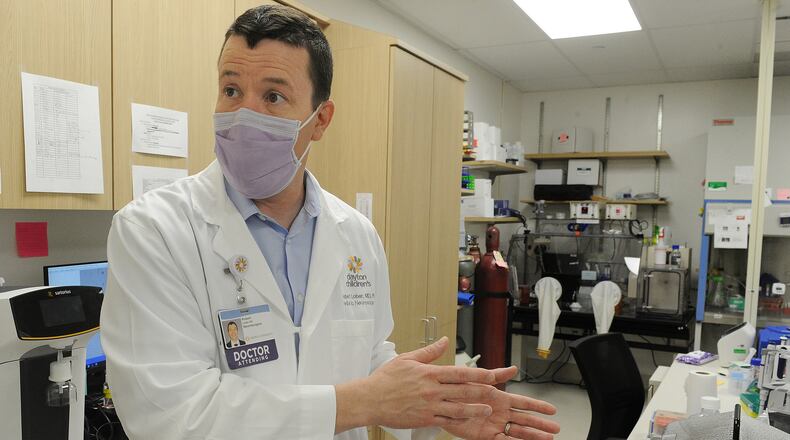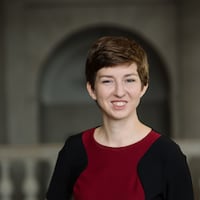Now researchers at the hospital are keeping a growing collection of donated pediatric brain tumors alive in a “bank” and sharing data around the world.
“Now we are able to actually save everything and all of it goes to research, which makes a lot of sense to us,” Lober said. “And everything we do is free and available to any researcher who requests it.”
Brain cancer recently passed leukemia as the deadliest cancer for children. Yet there hasn’t been much progress over the years when it comes to understanding causes and finding treatments. Some don’t respond to chemotherapy. Also, available brain cancer treatments can have harsh and long-term effects on kids.
Keeping brain tumors alive for research is changing that dynamic. The researchers can essentially “wake up” the tissue they have in storage in liquid nitrogen and grow it.
One tumor at the hospital’s biobank can be propagated into 100 tumors or more. That tumor can be shared with researchers all over the world, again and again.
“They’re immortal. They’ll grow until the end of time now,” Lober said.
Getting started
A challenging paradox is that brain cancer is both the No. 1 cause of disease-related death among children, but still rare enough that it’s hard to hone in on what treatment works.
Brain cancer isn’t a monolith and out of the 5,000 some cases a year found in U.S. kids, different types of tumors are found in different parts of the brain and central nervous system that progress differently and respond to treatment differently.
“When you say the words ‘brain tumors,’ you actually are not talking about just a single disease,” said Dr. Adam Resnick at Children’s Hospital of Philadelphia, the co-scientific chair at the Children’s Brain Tumor Network.
The relatively small market of patients hasn’t drawn out much private pharmaceutical research interest, and pediatric brain cancer research gets a fraction of the overall 4% of National Institute of Health funds marked for childhood cancers.
The number of kids with brain cancer also means that even in large health systems, doctors might only see a handful of those a year with a particular type of brain cancer.
That has all translated to decades of little progress. A drug has never been developed and approved specifically for malignant childhood brain tumors.
Credit:
Credit:
The Dayton biobank is part of the Children’s Brain Tumor Network, which has been laying new infrastructure to pick up the pace of research.
It takes many groups coming together to share a lot of data in order to make sense of what could actually help these kids. The network helped build platforms that allow researchers to access large collections of brain tumor data from anywhere in the world.
“The kind of information you can get from biospecimens is very diverse,” Resnick said. “Integrating that data with the clinical history, and the outcome of the patients, and the treatment, requires a large number of domains, stakeholders and experts.”
Treating disease that’s not common in any one hospital means researchers and clinicians have to share in a way that’s sometimes against the culture of academic medicine.
“For the network to be successful, we need to have folks like Robert at Dayton Children’s who really adopt a new model of academic research, which is committed to the sharing and access of data and specimen in the absence of potential personal credit,” Resnick said.
Tumor donations
Among the first brain tumor tissue added to the biobank was a donation from a Champaign County family. Blake Barr was diagnosed with a rare brain cancer in 2016 at 10 years old.
The softball-sized tumor had apparently grown in a few months. He received care at both Dayton Children’s and Children’s Hospital of Philadelphia, and was declared cancer free in spring of 2017.
“I will never forget looking at that image — something inside of Blake that should never be inside a child,” Amberly Barr, his mom, had said when asked about the family’s experience. “Donating it to science creates a sense of comfort that it doesn’t stop here. We are gaining understanding to prevent and stop childhood cancer and brain tumors. It creates hope for a whole bunch of families.”
Trisha Faris, neuro surgical assistant and research assistant, spends time with families and explains what they are doing with the donated tissue, and families have so far all said yes to donating the tumors. Some families have come down and toured the facility.
The lab’s work and collection has grown and the team is also accepting specimens from other areas.
Through the A Gift From a Child initiative, families of children who die from brain cancer can ask to have their brains donated and delivered to the lab. This happened about a month ago in the middle of the night when researchers were called and harvested the cells.
“This child is now going to find a way hopefully to heal other children,” Lober said.
Credit:
Credit:
Biobank one of many steps needed
The tumors that are grown into more tumors are shipped out through the partners with the Children’s Brain Tumor Network and to labs around the world. They’ve recently been shipped to Australia, New Jersey and St. Louis.
The approach is in many ways new. The team is learning every day the best “recipes” to get specific tumors to grow in a culture.
Low-grade gliomas are both notoriously hard to treat and hard to grow in a dish. However, Chanel Keoni, Dayton Children’s neuroscience laboratory coordinator, is finding success with a recipe.
Along with Lober, Keoni and Faris, team members include Pinki Chowdhury, a biomedical scientist, and Christopher Waker, a graduate student and research assistant.
The Gala of Hope Foundation — a local cancer fundraiser — raised the seed money to get the biobank started at Dayton Children’s.
“This is community supported entirely. This is happening here. And it’s actionable data that’s affecting the way that we treat patients,” Lober said.
Credit:
Credit:
After collecting the specimens and sharing, the next layer is researching and trying new therapies and treatments.
Resnick said when going through graduate school, the pipeline from the lab to impact in a patient could be 20 years. But that’s changed dramatically because of the kinds of large-scale data that someone can generate from biospecimens, and the new capacity to query that data and relate it to the patients in front of them, Resnick said.
“Time is the one variable that patients and families care about most and which they don’t have when your child is sick. And that’s a very different model of doing research than the pre-2005 model,” he said.
About the Author




